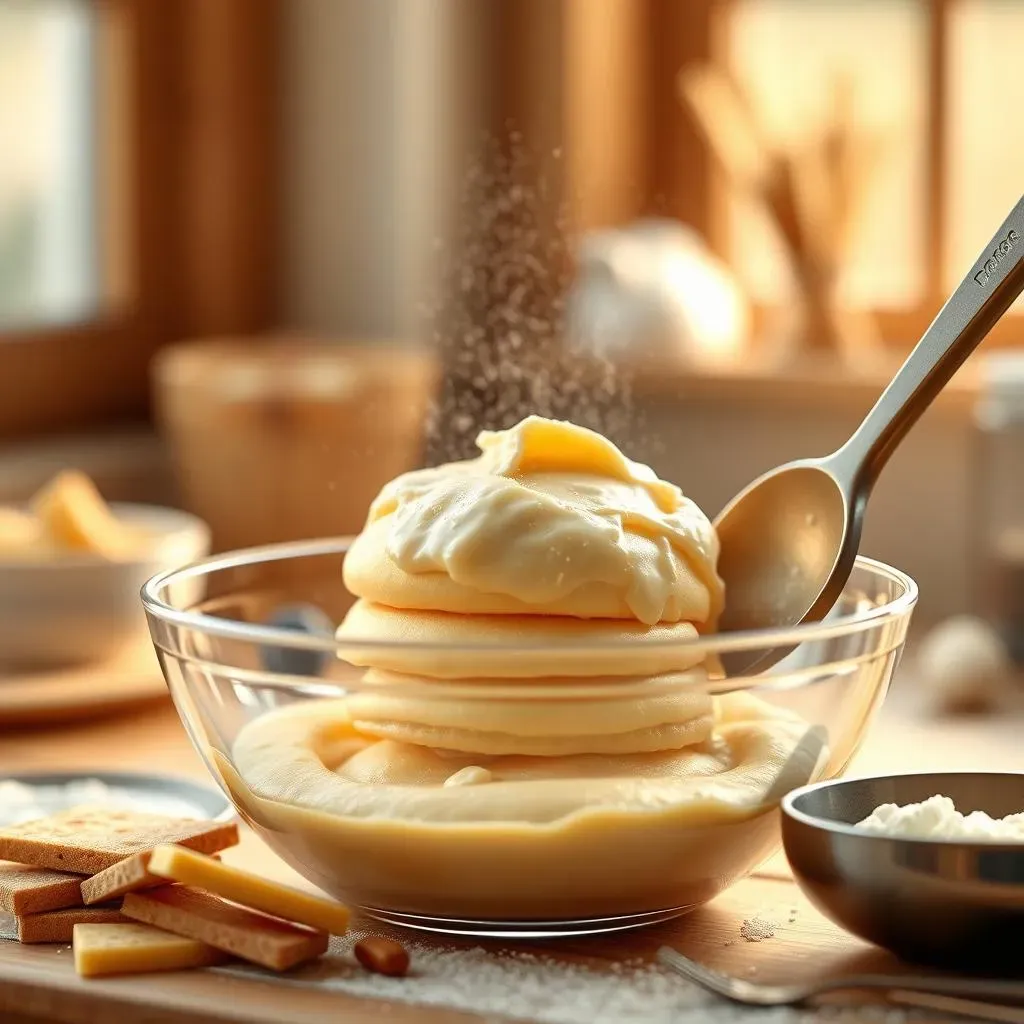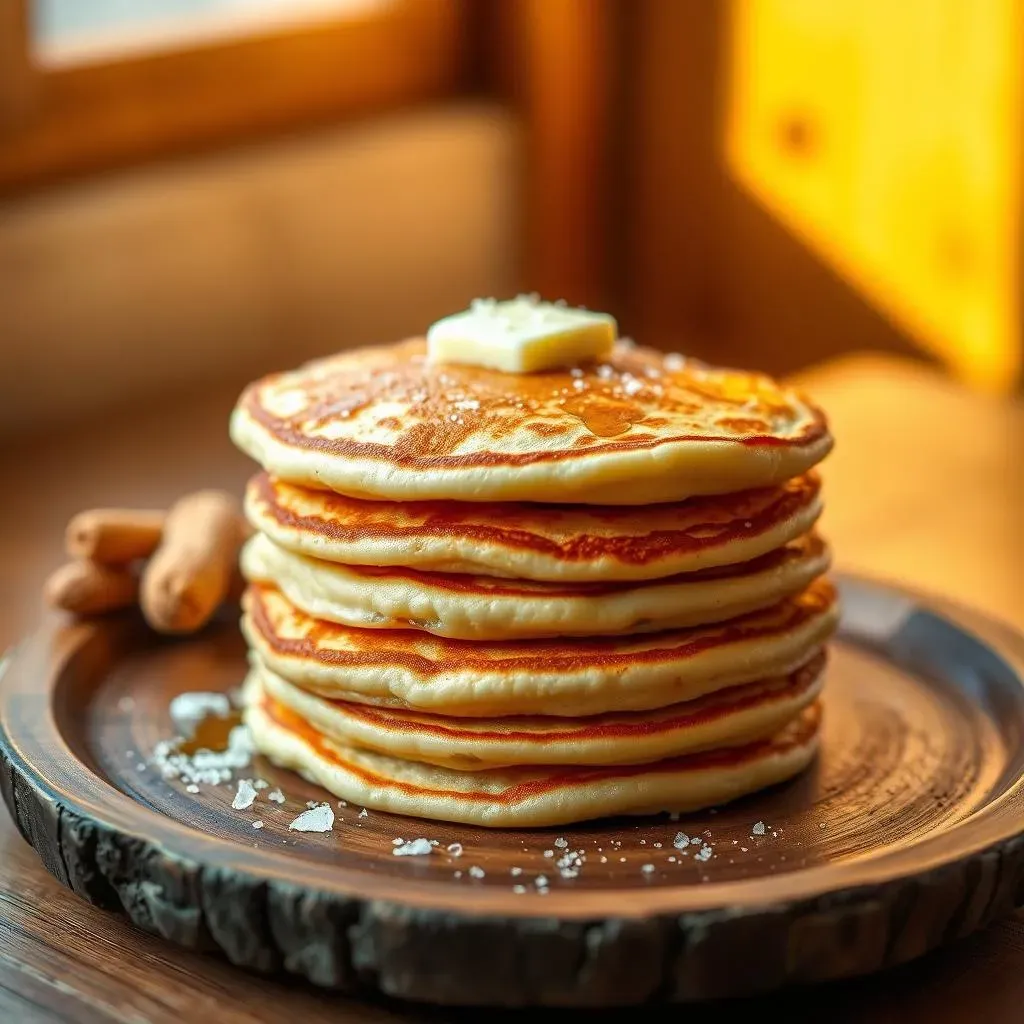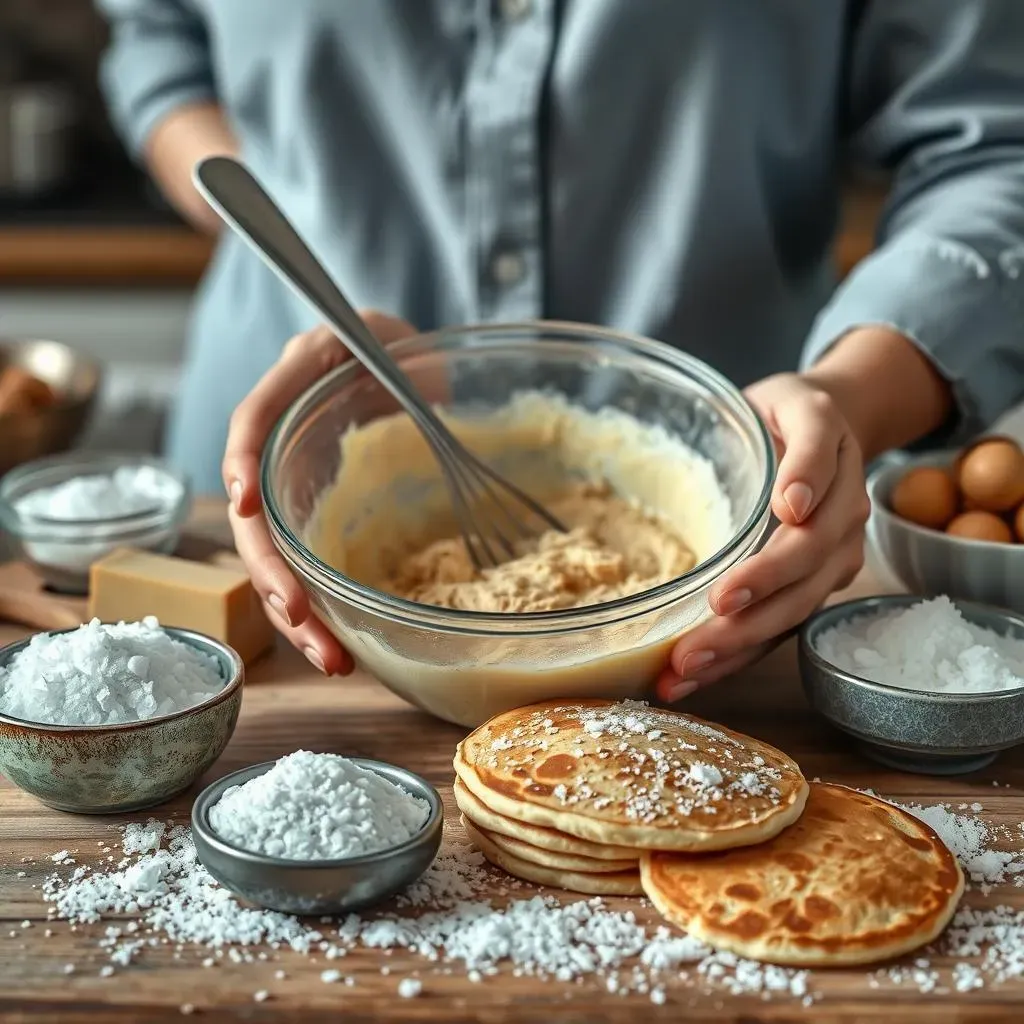Table of Contents
Ever wonder why your homemade pancakes sometimes taste flat, even when you've followed the recipe to a T? It's not always about the fancy ingredients or the perfect flip. Often, the magic lies in the simplest of elements: salt. Yes, that humble pinch you probably don't think twice about plays a surprisingly significant role in your breakfast stack. This isn't just about making your pancakes taste less bland. We're talking about a transformation in flavor, texture, and overall pancake perfection. So, if you've ever pondered "what does salt do in a pancake recipe," you're in for a treat. We'll break down the science, explore the real impact of this unassuming ingredient, and give you the knowledge to make your pancakes the envy of the breakfast table. Get ready to uncover the secrets behind that tiny but mighty pinch of salt.
The Science of Pancakes: Understanding the Base Ingredients

The Science of Pancakes: Understanding the Base Ingredients
The Foundation: Flour, Eggs, and Milk
Let's talk pancake basics, the stuff that's not so secret, but totally crucial. We're talking flour, eggs, and milk – the holy trinity of pancake batter. Flour, mostly starch, is like the structural engineer of your pancake. It soaks up the moisture from the eggs and milk, giving the batter its body. Think of it as the scaffolding that holds everything together. Then, eggs swoop in, bringing protein to the party. When cooked, that protein firms up, adding to the pancake's overall structure. It’s like the concrete that fills in the flour scaffolding. And milk? It's the liquid that makes the batter pourable, not to mention it helps with browning, giving your pancakes that gorgeous golden hue.
It's a delicate balance, you see. Too much flour, and you’re looking at hockey pucks, not fluffy pancakes. Too much milk, and you’ll have something closer to a crepe than a pancake. The ratio is key, and understanding this foundation is your first step towards pancake mastery. It's like knowing the basics of a good song before you start adding fancy riffs. You just can't skip it!
Ingredient | Role in Pancakes |
|---|---|
Flour | Provides structure, absorbs moisture |
Eggs | Adds protein, helps with structure |
Milk | Thins batter, aids in browning |
The Supporting Cast: Baking Powder and a Pinch of Salt
Now, let's bring in the supporting cast: baking powder and, of course, our star of the show, salt. Baking powder is your leavening agent, the secret weapon for achieving those light, airy pancakes that we all crave. It works its magic when it mixes with the liquid and heat, creating gas bubbles that make the batter rise. Think of it as the tiny, invisible balloons that inflate your pancakes, giving them that delightful fluffiness. Without it, you're stuck with flat, sad discs.
And then, there's salt, often an afterthought, but oh-so-important. We'll get into the nitty-gritty of its role in the next section, but for now, understand that salt isn't just about making your pancakes taste salty. It's the balancing act, the ingredient that brings out the best in all the others, keeping the sweetness in check and making the flavors pop. It's like the conductor of an orchestra, making sure all the different instruments play together in harmony. It's the unsung hero of the pancake world.
- Flour: The base, provides structure.
- Eggs: Adds richness and structure.
- Milk: Thins the batter and adds moisture.
- Baking powder: Creates light, airy texture.
- Salt: Enhances flavor and balances sweetness.
Salt's Surprising Role: More Than Just Flavor in Your Pancakes

Salt's Surprising Role: More Than Just Flavor in Your Pancakes
The Flavor Amplifier
Okay, so you might think salt's only job is to make things taste, well, salty. But in the world of pancakes, it's more like a flavor DJ, mixing and amplifying all the other tastes. It doesn't just add its own salty note; it actually enhances the sweetness of the sugar and the richness of the eggs and milk. It's like it's saying, "Hey, you there, flavor! Come on out and shine!" Think of it like adding a bit of lemon to a strawberry, suddenly the strawberry tastes even more strawberry-ish. That's what salt does, but for the whole pancake experience. It takes all the individual ingredients and makes them sing together in harmony.
Without salt, your pancakes might taste a little flat, a little one-dimensional. It's like listening to a song with the volume turned way down. You can kind of hear it, but you're missing the full experience. Salt is the volume knob for flavor; it turns up the dial, letting all the subtle nuances come to the forefront. It's a tiny pinch, but it makes a huge difference in how you perceive the taste of your breakfast. It's subtle but necessary, like the bass line in your favorite song.
The Texture Transformer
But hold on, salt's talents don't stop at just flavor. It also plays a part in the texture of your pancakes, which is pretty cool, right? While it’s not a primary leavening agent like baking powder, salt does have a subtle effect on the gluten in the flour. It helps to strengthen the gluten structure, which can lead to a slightly more tender pancake. It's like adding a tiny bit of glue to the flour, making it hold together better. This means your pancakes are less likely to crumble or fall apart when you're trying to flip them, which is always a win.
Now, I know what you’re thinking, “salt makes pancakes tender?” Yep! And here’s the thing, while we often think of salt as something that dries things out, in a pancake batter, it actually helps to retain moisture. It's like a tiny bodyguard for the water molecules, making sure they don't evaporate too quickly. This results in a pancake that's moist and fluffy on the inside, not dry and crumbly. It's like having a built-in humidifier for your breakfast. Salt is not just a flavor enhancer; it's a texture wizard too, working its magic behind the scenes.
Salt's Role | How it Works |
|---|---|
Flavor Amplifier | Enhances sweetness and other flavors |
Texture Transformer | Strengthens gluten, retains moisture |
How Salt Balances Flavors and Enhances Texture: The Real Impact

How Salt Balances Flavors and Enhances Texture: The Real Impact
The Flavor Balancing Act
Okay, let's get into the nitty-gritty of how salt actually balances flavors. It's not just about making things salty, not at all. Think of it like this: your pancake batter is a group of different personalities. You've got the sweetness from sugar, the richness from eggs, the subtle flavor of milk, and the earthy notes from flour. Salt is like the mediator, the one that brings all these different personalities into harmony. It mellows out the sweetness, prevents it from becoming overpowering, and at the same time, it elevates the other flavors, making them more pronounced and complex. It's like a well-balanced seesaw, where salt is the fulcrum, ensuring that nothing is too much or too little.
It's a subtle dance, this flavor balancing act. Too little salt, and the sweetness can become cloying, and the other flavors might get lost in the background. Too much salt, and you've got yourself a salty pancake disaster. The right amount of salt, though, is like the secret ingredient that makes everything come together, creating a flavor profile that's both satisfying and complex. It's that "je ne sais quoi" that makes you say, "Wow, these pancakes are amazing!" It's not just about the taste of salt; it's about how it makes all the other tastes better.
Texture Enhancement: A Subtle Art
Now, let's talk about the texture side of things. We've touched on it before, but it's worth going deeper. Salt's impact on texture is more subtle than its impact on flavor, but it's there, working its magic. The key is how salt interacts with the gluten in the flour. Gluten, for those who don't know, is what makes dough stretchy and elastic. While we don't want super stretchy pancakes, we do want them to have some structure. Salt helps to control the gluten development, preventing it from becoming too strong, which can lead to tough pancakes. It's like a gentle hand guiding the gluten, ensuring it behaves properly.
And here's the cool part: salt also helps with moisture retention. It's not like a sponge, but it does help to keep the water from escaping too quickly during cooking. This means your pancakes are more likely to stay nice and moist on the inside, rather than drying out and becoming crumbly. It’s like the salt creates a protective barrier, keeping all the good stuff locked in. This results in a pancake that’s not only flavorful but also has that perfect melt-in-your-mouth texture. It's like a tiny detail that makes a big difference in the overall experience of eating your pancakes. It's the difference between a good pancake and a great one.
Salt's Impact | Explanation |
|---|---|
Flavor Balance | Mellows sweetness, enhances other flavors |
Texture Control | Manages gluten, retains moisture |
Experimenting with Salt: Tips and Tricks for Perfect Pancakes

Experimenting with Salt: Tips and Tricks for Perfect Pancakes
The Right Amount: Finding Your Sweet Spot
Alright, so now that you're a salt expert, let's talk about how to actually use it. The key here is to find your sweet spot, that perfect amount that enhances flavor without making things taste salty. Most recipes call for a pinch of salt, and that's a good starting point. But, what exactly is a pinch? Well, it's roughly about 1/8 to 1/4 of a teaspoon. Start with that, and then taste your batter. You want to taste a subtle hint of salt, not an overwhelming saltiness. Remember, we're not making pretzels here; we're making pancakes. If the batter tastes flat, add a tiny bit more salt, like a tiny dash, and mix again. It's a delicate balance, but you'll get the hang of it. It’s like tuning an instrument; you make small adjustments until it sounds just right. Keep in mind, that different types of salt have different levels of salinity, so it's important to use the same type of salt that the recipe calls for or be prepared to adjust the amount.
Also, consider the other ingredients you're using. If you're adding something particularly sweet, like a lot of maple syrup or fruit, you might want to lean towards the higher end of that 1/8 to 1/4 teaspoon range. If, on the other hand, you're going for a more savory pancake, maybe with some herbs or cheese, you might want to dial it back a bit. It's all about playing with the flavors and finding what works best for your taste buds. Think of it as a personal experiment. It's not a science; it's a culinary adventure, where you're the chef and you get to decide what tastes best. Don't be afraid to make mistakes, that’s how we learn!
Salt Amount | Effect |
|---|---|
Too Little | Flat, one-dimensional flavor |
Just Right | Balanced, enhanced flavors |
Too Much | Salty, unpleasant taste |
Different Salts, Different Results
Now, let's get a little fancy and talk about different types of salt. Yes, there's more than just your standard table salt. There's sea salt, kosher salt, Himalayan pink salt, and even fancy flavored salts. Each one has a slightly different texture and flavor profile, and they can all affect your pancakes in different ways. Table salt, for example, is very fine and dissolves quickly, while kosher salt is coarser and has larger crystals. Sea salt can have a more complex flavor, depending on where it's sourced. Himalayan pink salt, well, it's just pretty, right? It's like choosing different brushes for a painting; they all have different effects. Experiment with different salts, and you might just discover a new favorite.
When it comes to pancakes, I’d recommend sticking with either table salt or kosher salt. They both work well and are readily available. But, if you're feeling adventurous, go ahead and try a pinch of sea salt or a flavored salt. Just remember to adjust the amount accordingly. Coarser salts, like kosher or sea salt, tend to be less dense than fine table salt, so you might need to use a little more to get the same level of saltiness. It's like using different types of paint; you need to adjust your technique to get the desired result. Just keep notes, and have fun with it! You never know what amazing flavor combinations you might discover.
- Table salt: Fine, dissolves quickly, good for general use.
- Kosher salt: Coarser, less dense, great for even seasoning.
- Sea salt: Varied flavors, depending on the source, use for a subtle flavor boost.
- Flavored salts: Adds a unique twist, use sparingly.
The Final Sprinkle: Salt's Lasting Impact on Pancakes
So, there you have it. Salt isn't just a background player in your pancake recipe; it's a key conductor in the symphony of flavors and textures. It's the tiny pinch that balances the sweetness, enhances the other ingredients, and ensures that each bite is a delightful experience. Understanding what salt does in a pancake recipe isn't about being a culinary scientist, it's about appreciating the subtle nuances that transform a simple breakfast into something truly special. Now, armed with this knowledge, go forth and create pancakes that are perfectly balanced, flavorful, and utterly irresistible. Happy flipping!